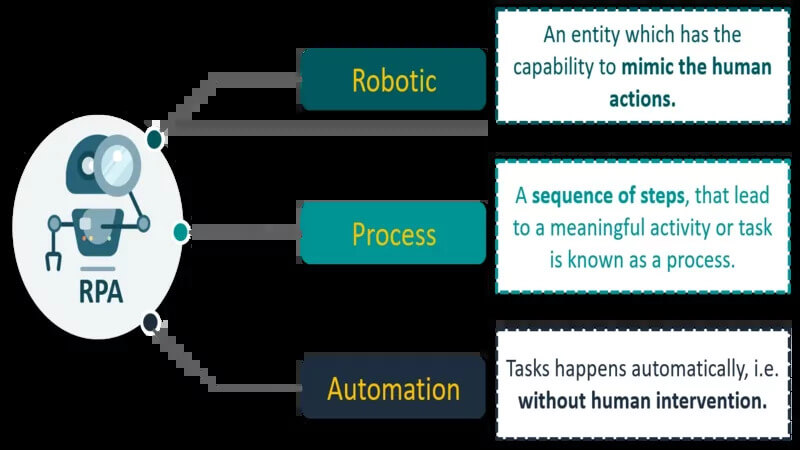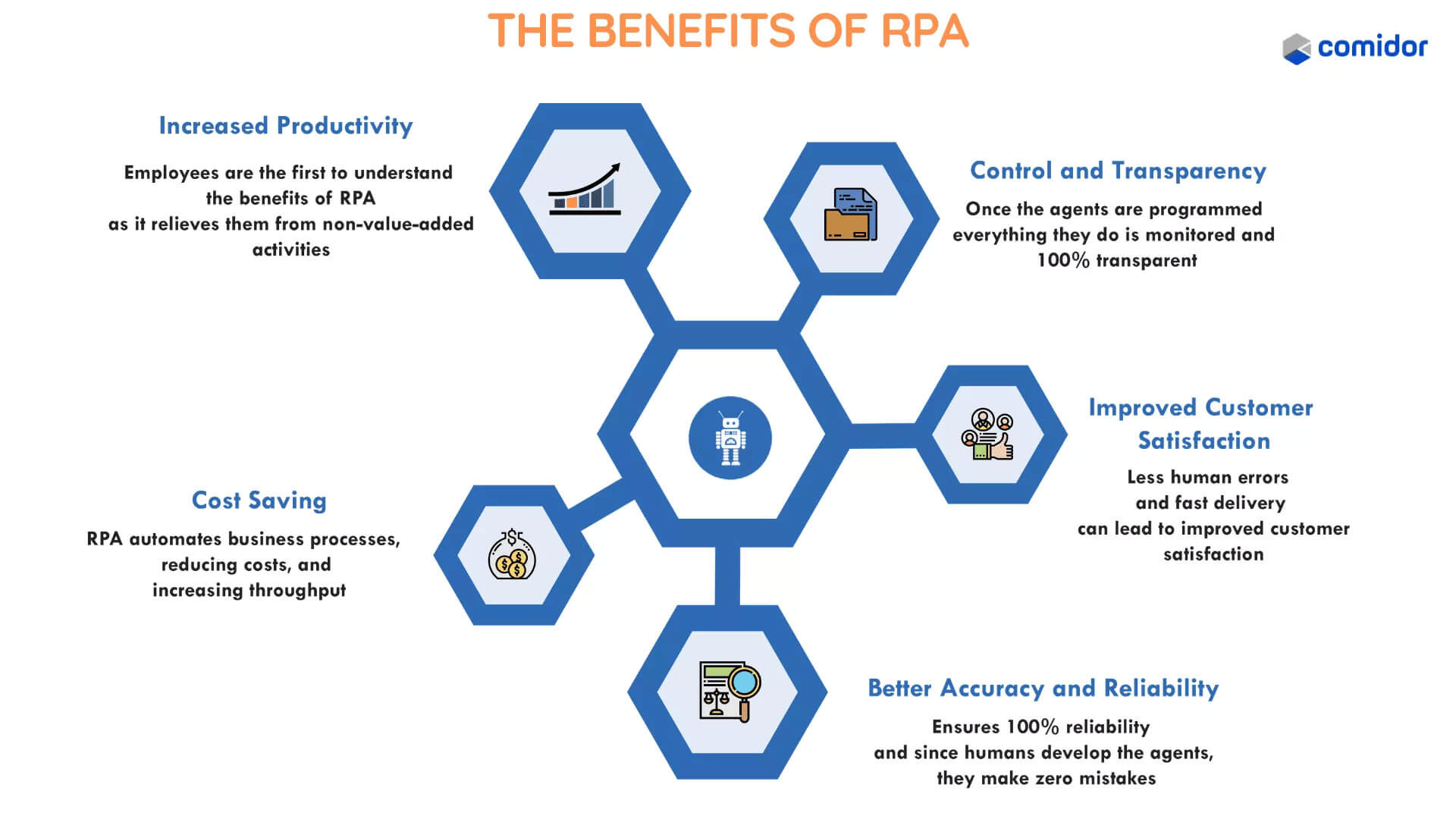- Why is Robotic Process Automation important to the healthcare industry?
- Automation in Medical Records
- What are three RPA tools?
- What is an example of RPA?
- Robotic Process Automation (RPA): 6 use cases for healthcare providers
- How RPA works in Healthcare
- Benefits of RPA to Healthcare Organizations
- Conclusion
Robotic process automation in healthcare is a rapidly growing AI technology with the potential to transform the healthcare industry. Many healthcare organizations are turning to RPA to streamline repetitive processes and improve efficiency. With the unique solution RPA offers, healthcare providers can focus more on improving the patient experience.
However, some healthcare practitioners still need to learn how powerful and beneficial robotic process automation can be. In this blog post, we will discuss the value and major use cases of RPA. We will also look at how healthcare automation can improve your organization.
Why is Robotic Process Automation Important to the Healthcare Industry?
Robotic process automation plays an integral role in boosting the overall performance of healthcare systems. It has the ability to complete tedious, time-consuming tasks accurately and provides numerous benefits to the healthcare industry. RPA increases administrative efficiency, boosts productivity, reduces costs, and eliminates mundane tasks without much human intervention.
It enables healthcare providers to focus on more essential patient-facing tasks while streamlining operational processes.
RPA use can provide the healthcare industry with insights into its processes. This will allow them to add more value to the healthcare business.

Automation in Medical Records
Automating medical records is one of the core functions of RPA. By automating the handling of health records, healthcare providers can reduce the need for manual work. This eliminates unnecessary delays, increases efficiency, and ensures cost savings.
Robotic process automation is useful in creating and maintaining a patient’s medical record. This task usually requires a great deal of precision and attention to detail. That makes it prone to human error when done manually. In addition, RPA helps collect data from multiple sources, such as lab results, imaging results, and doctors’ notes.
This data can then be automatically organized and validated to ensure consistency throughout the patient’s record. As a result, healthcare institutions have more accurate and up-to-date information to improve patient care.
MICROSOFT CLOUD FOR HEALTHCARE: HOW MS CLOUD SOLUTIONS ARE BENEFITING HEALTHCARE ORGANIZATIONS
One of the most common uses of RPA for patient records is data slicing and dicing. Data slicing and dicing is used to quickly and easily divide a large dataset into smaller, more manageable chunks. This is extremely useful in the health sector.
It allows healthcare professionals to quickly review important patient data and make decisions based on that data. For instance, if a doctor requires a patient’s medical data, they can quickly slice and dice the entire record to access the specific data needed.
Another way RPA is used in this case is to automate data transfer between various healthcare providers. For instance, if patients need to transfer their medical history records from one provider to another, RPA facilitates the process.
AGILE HEALTHCARE: HOW TO IMPLEMENT THE APPROACH
This saves time and reduces possible human errors. Additionally, since RPA can safely automate the process, it complies with HIPAA guidelines.
RPA can also send reminders or messages about upcoming appointments or follow-up tests. This frees up staffing resources for other tasks. Similarly, repetitive tasks like billing and claim processing can be automated with RPA. This reduces the amount of time it takes to process claims and speeds up payments for both patients and providers.
In a nutshell, RPA is proving to be a powerful tool for the successful management of different forms of records in the healthcare industry.
What are Three RPA Tools?
Robotic process automation tools are typically designed and configured for specific business processes. They help streamline these processes by significantly reducing the time required to complete tasks. Three popular RPA tools are Blue Prism, UiPath, and Automation Anywhere. Let’s briefly discuss each of them.
Blue Prism is a leading RPA software platform for automating business operations and processes. It enables users to easily build, deploy, manage, and scale their automated processes. This helps them to take full advantage of modern technologies like cloud computing and AI. Blue Prism processes easily integrate with different enterprise systems and can manage exceptions and process significant amounts of data. Besides providing accurate, reliable, and secure processes, Blue Prism offers fast and easy scalability to meet the needs of growing businesses.
KEY DIFFERENCES IN EHR VS. EMR VS. PHR: WHAT TO CHOOSE FOR YOUR HEALTHCARE ORGANIZATION
UiPath is an RPA platform that automates manual and monotonous tasks; UiPath comes with an intuitive user interface and a simple drag-and-drop feature. Other tool features include screen scraping, exception handling, and PDF data extraction. In addition, UiPath supports web, web service, and data-driven processes, enabling users to deploy bots quickly across all systems. UiPath also allows users to store data in secure, encrypted repositories to ensure compliance and version control.
Automation Anywhere is an AI-powered, enterprise-grade robotic process automation platform that enables businesses to automate processes fast and cost-effectively. It provides advanced tools for robotic process automation, data scraping, AI, analytics, and more. This software eliminates manual processing and enhances operational efficiency while reducing costs. In addition, Automation Anywhere provides a secure environment to store data and enables users to extract and obtain insights from the data. With its deep integration functions, Automation Anywhere is one of the most popular RPA tools in the market.
KEEP A PULSE ON EPIC APP ORCHARD AND HOW IT BENEFITS THE HEALTH SYSTEMS
What is an Example of RPA?
The insurance industry is a great candidate for the use of RPA. This is due to the large amount of data that must be processed to manage policies effectively. A practical example of RPA use in the insurance industry is processing new policy notices.
When a customer signs up for an insurance policy, an RPA system scans documents and extracts important data. The data is then entered into the insurer’s systems. This intelligent document processing can reduce the time it takes for a new policy notice to be fully processed. It also reduces the chances of errors in inputting data. Furthermore, RPA applications are used for insurance claims management and verifying policy information. As a result, RPA automation significantly improves the customer experience in many industries.
HEALTHCARE CYBERSECURITY: HOW TO PROTECT PATIENT DATA
Robotic Process Automation (RPA): 6 Use Cases for Healthcare Providers
RPA has many potential use cases in healthcare to improve efficiency and automate manual tasks. Below are some of the major use cases of this powerful artificial intelligence tool.
RPA is used for electronic medical record (EMR) data entry to simplify the process of collecting and transforming the data of patients into consistent formats. This facilitates faster healthcare delivery and reduces the use of paper documents and files.
RPA use helps verify claims data and ensure smooth and timely processing of payments.
RPA is used to facilitate patient scheduling automatically. This makes appointments with a doctor and follow-up communications with patients efficient.
RPA bots can automate the process of identifying and ordering necessary medical supplies while monitoring inventory levels.
RPA is used to send out billing notifications, follow up on patient accounts, and collect payments.
RPA automatically checks for and monitors compliance with industry regulations and standards within the medical field.
HEALTHCARE APPS DEVELOPMENT: TYPES, EXAMPLES, AND FEATURES
How RPA works in Healthcare

The core purpose of Robotic Process Automation (RPA) in healthcare is to streamline the most mundane and labor-intensive tasks.
RPA works by utilizing bots to simulate the actions of human workers on computer systems. Such activities include forward and backward movements of a mouse, data entry, and requests for specific applications.
The software bots are typically accessed and managed through graphical user interfaces. This means they don’t need programming proficiency to be executed or controlled. Instead, RPA bots replicate the same data manipulation, interaction with user interfaces, and data exchange with other digital systems as a human user would do.
The use of RPA technology for healthcare services is expected to grow with the implementation of new healthcare regulations. The regulations are intended to reduce mistakes and speed up the EHR process by automating manual activities that need human workers.
PREDICTIVE ANALYTICS VS. MACHINE LEARNING: WHAT IS THE DIFFERENCE
Healthcare professionals, however, face unique challenges in implementing RPA. Medical processes and data are complex and highly sensitive. This means providers must have the right strategy, technology, and expertise to comply with regulatory and security standards. In addition, intelligent automation processes must be customized for each healthcare organization within the healthcare industry.
The most common areas for implementing RPA include clinical operations and administrative services. For example, clinical operations tasks such as laboratory testing and insurance verification can be automated using RPA. By automating these processes, healthcare providers can reduce the time spent and effort used by their staff. And also reduce errors in results.
Data Mining Vs. Predictive Analytics: Know The Difference
RPA also provides opportunities for healthcare providers to improve the patient experience. For instance, by automating the scheduling and registration processes, patients will have a leisurely experience signing up for appointments and checking in. In addition, RPA can ensure more accuracy of medical information and reduce the risk of errors when data entry is done manually.
In summary, RPA can help healthcare organizations to simplify their workflow, reduce costs, and improve the patient experience. With the right strategy and implementation, healthcare providers can realize the benefits of RPA and reap the rewards from improved patient outcomes.
Benefits of RPA to Healthcare Organizations

Here are some benefits healthcare organizations can enjoy by using RPA:
RPA can reduce costs by eliminating manual labor and delivering more incredible accuracy. In addition, it removes mistakes caused by manual data entry.
RPA allows for improved tracking and tracing of workflow in the healthcare system. This will enable better data sharing and records management.
RPA brings efficiency to the decision-making process. It improves data analysis by notifying decision-makers of any changes or the emergence of new data in real-time.
By automating workflows, organizations can devote more time to patient care. This delivers a higher quality of service and satisfaction.Streamlined Medical Claims
RPA can automate medical claims processing, significantly reducing errors and decreasing processing time.
Automating processes lowers the risk of data breach and fraud through greater security and enforcement of data protection protocols.
Automating specific processes can speed up ensuring compliance, improving security, and reducing risks.
Automated healthcare processes can reduce labor costs by replacing manual labor with more efficient, cost-effective tasks.
The intelligent automation provided by RPA can deliver a better overall experience for patients. It does this by accurately updating medical information and responding on time.
THE APP SOLUTIONS – CUSTOM HEALTHCARE SOFTWARE DEVELOPMENT COMPANY
Conclusion
RPA has the potential to significantly improve the efficiency and accuracy of many tasks in the healthcare industry. As a result, RPA can help healthcare professionals deliver high-quality patient care by taking over repetitive, time-consuming tasks. As the technology continues to advance, we can expect to see even more applications of RPA in healthcare, leading to better, more efficient care for all.

